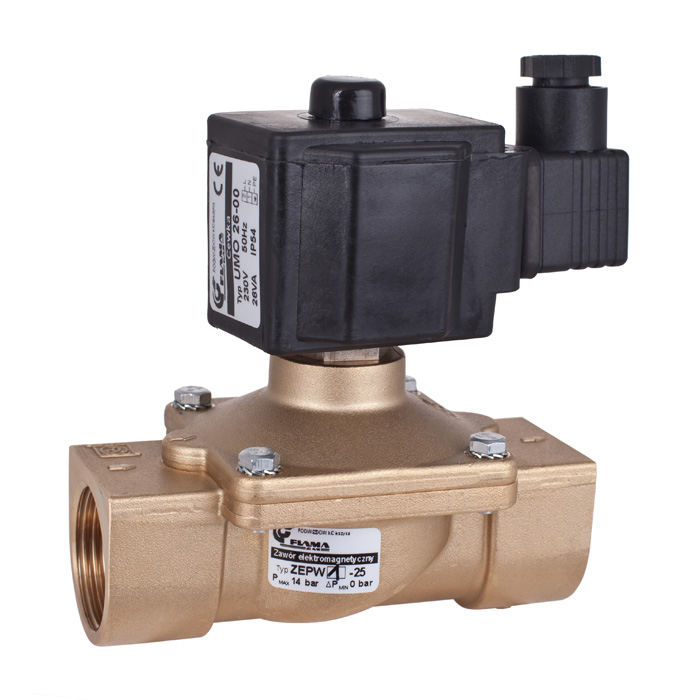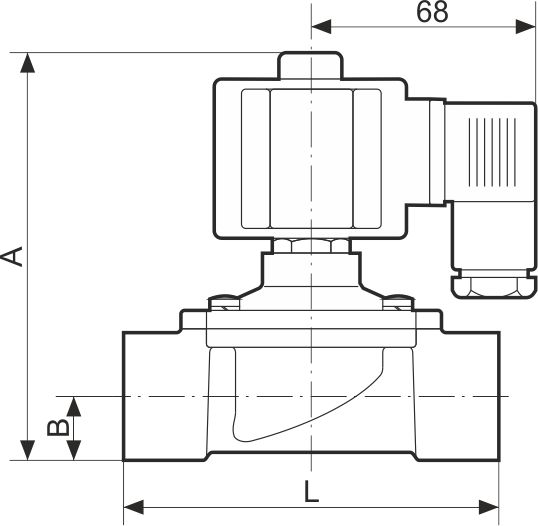Project Description
Solenoid valve ZEPW
 2/2 NC
2/2 NC- membrane, assisted lift
- suited to zero pressure differential conditions (ΔPMIN= 0 bar)
- performed with different versions of seals
- in control rooms for two-position gas or liquid flow control
- in pneumatic and hydraulic control systems
- in water circuits (cold and hot), heating systems
- must not be used for gaseous fuels (methane, propane-butane)
| Fluid media | Water, water solutions, air and non-aggressive liquids (oils) and gases |
| Pressure | See tab „Dimensions / Pressures” |
| Fluid media temperature Tm | See data table |
| Ambient temperature | -10°C ÷ +60°C |
| Voltage | AC(50Hz) 24V, 230V; DC 24V |
| Power | AC 26VA, DC 26W |
| Opening time | < 1,5s |
| Closing time | < 1,5s |
| Connection frequency | max. 40 1/min |
| Fluid media viscosity | max. 11,8mm²/s (2°E) |
| Operation type | Continuous (100%) |
| Degree of protection | IP54 |
| Valve body material | Brass |
| Sealing material | 1 – NBR, 3 – EPDM PEROXY |
| Mounting position | coil upwards -acceptable deviation from vertical position up to 90O |
| Typ | DN | Rp | A [mm] |
B [mm] |
E* [mm] |
L [mm] |
PMAX[bar] | ΔP[bar] min/max | Kv** [m³/h] |
M [kg] |
Tm [°C] |
Ru |
|---|---|---|---|---|---|---|---|---|---|---|---|---|
| Threaded connection: | ||||||||||||
| ZEPW1-10 | 10 | 3/8 | 105 | 14 | 54** | 84 | 14 | 0/14 | 2,1 | 0,73 | +90 | 1 |
| ZEPW3-10 | 10 | 3/8 | 105 | 14 | 54** | 84 | 14 | 0/14 | 2,1 | 0,73 | +140 | 3 |
| ZEPW1-15 | 15 | 1/2 | 105 | 14 | 54** | 84 | 14 | 0/14 | 2,5 | 0,70 | +90 | 1 |
| ZEPW3-15 | 15 | 1/2 | 105 | 14 | 54** | 84 | 14 | 0/14 | 2,5 | 0,70 | +140 | 3 |
| ZEPW1-20 | 20 | 3/4 | 115 | 20 | 66 | 113 | 14 | 0/14 | 5,8 | 1,54 | +90 | 1 |
| ZEPW3-20 | 20 | 3/4 | 115 | 20 | 66 | 113 | 14 | 0/14 | 5,8 | 1,54 | +140 | 3 |
| ZEPW1-25 | 25 | 1 | 115 | 20 | 66 | 113 | 14 | 0/14 | 6,8 | 1,47 | +90 | 1 |
| ZEPW3-25 | 25 | 1 | 115 | 20 | 66 | 113 | 14 | 0/14 | 6,8 | 1,47 | +140 | 3 |
* – maxiumum width of valve
** – 42mm for valve without coil
- suited to applications where pressure differential ΔP fluctuates or is very hard to define
- they work properly regardless of the differential pressure ΔP on the valve – although they use process pressures for operation
- they can be used from zero to the maximum PMAX operating pressure on which they have been designed
- have relatively high flow resistance (low Kv) – design considerations
- are sensitive to contamination – proper purity of the medium fluid should be ensured (filters application)
- long actuation times – low connecting frequency
- lifespan – less than for direct acting valves (several hundred of thousand work cycles)



